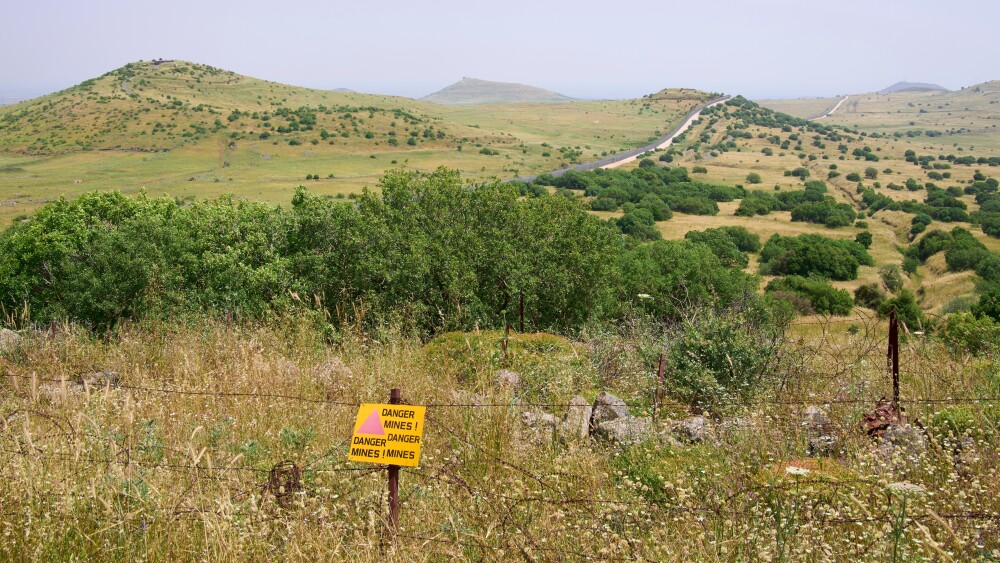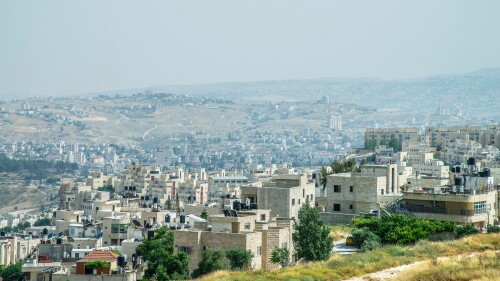In the first incident of its kind since the fall of the Assad regime, two rockets were fired from Syria at the Golan Heights on June 3. According to a report by the Alma research center, which focuses on events on Israel’s northern front, the rockets were likely launched from the town of Tasil in the southern part of the border area (once noted for the presence of Islamic State fighters). The report noted that the rockets fell in open areas near Hispin and Ramat Hamagshimim.
The rocket launch did not appear to presage the launch of a sustained campaign or insurgency against Israel from the Syrian border area.
The rocket launch did not appear to presage the launch of a sustained campaign or insurgency against Israel from the Syrian border area. Still, with Israeli forces deployed up to the Bravo Line of the (formerly) demilitarized zone in Syria’s Quneitra Province, and with the new government in Syria possessing only a limited ability to project power within its own area of control, the conditions for such a campaign are present.
The question is: Who is trying to take advantage of these conditions? Who was responsible for the rocket launch, and who are the forces currently seeking to organize for armed action against Israel on the Syrian border?
Two claims of responsibility were made for the rocket fire. The first was issued by a previously unknown Palestinian entity calling itself the Martyr Mohammed Deif Brigades. This claim lacked credibility, however.’
IRGC terror proxy emerges in Syria
The group’s Telegram channel issued a clip showing nighttime explosions taking place in an unidentifiable area. But the entirety of this organization’s output on its channel, other than this claim of responsibility, consists of clips and messages concerned with Gaza, as would be expected from its name. Other Palestinian organizations quickly disassociated themselves from the group’s claim.
A second, more substantive claim of responsibility came a few hours later. This was in the name of the Islamic Liberation Front in Syria and included a blurred clip of the rockets supposedly before they were launched.
This organization has a traceable record of activity in southern Syria. Although it can’t be said with certainty that its claim is authentic, it is plausible, and this organization appears most likely to have been behind the rocket launches.
SO WHAT is the Islamic Liberation Front in Syria, who stands behind it, and how concerned should Israel be? From the very first days following the toppling of the Assad regime, evidence began to emerge of efforts by elements linked to the former regime to create new structures to fight both Israel and the new authorities in Damascus.
On December 17, 2024, just a week after the regime’s fall, a new group called the Southern Liberation Front was formed, according to a statement issued on January 9 by the organization. As noted in a report by Hamdi Malik, a key expert on Iran-supported militia networks in the region, the statement cited the new organization’s goals as fighting “the Israeli occupation’s advance into our lands in southern Syria, specifically in the governorates of Quneitra, Deraa, and the western countryside of Damascus.”
On January 11, a second statement was issued on the same Telegram channel, in which the group changed its name and reformulated its goals. The second statement contained clearer identifications of the group’s origins and orientation.
The group now announced that it was changing its name to the Islamic Resistance Front in Syria – Possessors of Strength. This somewhat unwieldy title appears at the top of the January 11 statement, wrapped around a red logo depicting a hand holding up an automatic rifle.
Such iconography is a version of the logo of the Islamic Revolutionary Guards Corps (IRGC), which tends to be replicated by that organization’s various proxies in the region, most notably the Lebanese and Iraqi Hezbollah groups.
The document goes on to announce the commencement of “military operations” against the “Zionist occupation.”
The phrase “Possessors of Strength,” Malik notes, was used by Hezbollah’s current leader, Naim Qassem, to describe the fighting between Hezbollah and Israel in late 2024.
The statement begins with an expression of outrage at the destruction by the “Zionist enemy” over the preceding “month and 10 days of the capacities of the Syrian Arab Army,” which, in the view of the statement’s authors, had constituted the “first line of defense of the Arab nation.”
The document goes on to announce the commencement of “military operations” against the “Zionist occupation,” and claims that Israel’s actions form part of a larger Zionist plan to conquer the land between the Nile and the Euphrates.
IT DOES NOT require exceptional research or analytical skills to draw the obvious conclusion from these symbols and this language: The authors of this document are associated with the Iranian interest in Syria, and with the fallen regime.
Nevertheless, the document goes on to disclaim any associations with any “state or party or movement, internal or external,” and to describe the new movement as an “uprising against the Zionist occupation.”
Since the January 11 statement, the Islamic Resistance Front in Syria has claimed responsibility for several actions. On January 24, it claimed to have downed an Israeli drone in the Tal al Ahmar area of Quneitra province.
On February 21, the organization reposted a statement on its Telegram channel, claiming to be engaged in insurgency against “takfiri [Muslims who excommunicate coreligionists] terrorist organizations and the de facto government in Damascus,” thus notably setting itself also against the current governing authority in Syria.
The claim of responsibility for the June rocket fire was made by the group’s spokesman, Abu al Qasam, and was then confirmed in a media interview placed at the group’s Telegram Channel by a Mahmoud Mawaldi, who claimed to be the head of the “political office” of the Islamic Liberation Front in Syria.
In the interview, he described the rocket fire as a “message to the enemy” and said several times that it was only “the beginning.” He also described the Islamic Resistance Front as a political movement, and not only a military group, with ambitions beyond Syria’s south.
As of now, the IRGC’s forces in Syria appear to be only in the first stages of gathering anew. It would be advisable to keep an eye on them.
HOW CONCERNED should Israel be? Firstly, it should be noted that pro-Iran armed groups operating close to the Israel-Syria border are not a new phenomenon. They existed, operated by the IRGC and Hezbollah, before president Bashar Assad’s fall. These groups never constituted a major element in Iran’s effort to surround Israel with proxy Islamist military-political organizations. The capacities of the Islamic Resistance Front in Syria, beyond its bombastic rhetoric, appear severely limited.
Nevertheless, its emergence is a notable indication that the IRGC and its methods have not disappeared in the wake of the severe setbacks suffered by Tehran over the last year. Rather, they are alive and kicking, and doing their best to organize along familiar lines.
In the Syrian context, stability remains distant. The elements of the population associated with the former regime are vulnerable and face daily acts of revenge from the Sunni Arab victors in the civil war.
This fragmented and unstable reality is the kind of environment in which the IRGC has flourished. As of now, their forces in Syria appear to be only in the first stages of gathering anew. It would be advisable to keep an eye on them.








